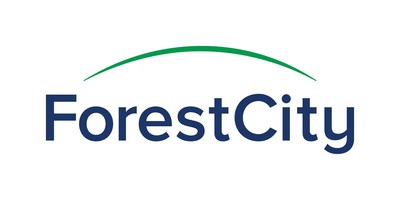
Forest City Reports 2017 Fourth-Quarter and Yearend Results
PR Newswire
CLEVELAND, Feb. 8, 2018
CLEVELAND, Feb. 8, 2018 /PRNewswire/ -- Forest City Realty Trust, Inc. (NYSE: FCEA) today announced financial results for the three months and year ended December 31, 2017.

Net Earnings/Loss
The company had 2017 fourth-quarter net earnings of $102.9 million, or $0.38 per share, compared with net earnings of $1.8 million, or $0.01 per share for the fourth quarter of 2016. For the year ended December 31, 2017, the company had net earnings of $206.0 million, or $0.78 per share, compared with a net loss of $158.4 million, or $0.61 per share, for the year ended December 31, 2016. Per share amounts throughout this release are presented on a fully diluted basis.
The primary drivers of the net earnings variance for the fourth quarter included higher gains on disposition of non-core assets, increased tax benefit and a 2016 interest rate swap breakage fee that did not recur. These positive factors were partially offset by higher organizational transformation costs and severance, compared with the fourth quarter of 2016.
In addition to these fourth-quarter factors, the net earnings variance for the full year was driven primarily by lower 2017 impairments, partially offset by 2016 gains from dispositions.
Additional factors impacting net earnings/loss for the three months and year ended December 31, 2017, are described below under FFO and Operating FFO and are included in the company's supplemental package for the quarter ended December 31, 2017, furnished to the SEC on Form 8-K. The Form 8-K and supplemental package are available on the company's website, www.forestcity.net.
Revenues
Consolidated revenues for the fourth quarter were $225.9 million, compared with $239.7 million for the fourth quarter of 2016. For the year ended December 31, 2017, revenues were $911.9 million, compared with $929.5 million for the year ended December 31, 2016.
Funds From Operations (FFO)
Fourth-quarter FFO was $113.8 million, or $0.42 per share, compared with $80.4 million, or $0.31 per share for the fourth-quarter of 2016. FFO for the year ended December 31, 2017 was $422.1 million, or $1.58 per share, compared with $241.7 million, or $0.92 per share for the year ended December 31, 2016.
As noted under Net Earnings/Loss, drivers of the positive quarter-over-quarter FFO variance included increased tax benefit and a 2016 interest rate swap breakage fee that did not recur in 2017, partially offset by higher organizational transformation costs and severance. The year-over-year FFO variance was primarily driven by 2016 impairment of non-depreciable real estate that did not recur in 2017, partially offset by 2016 gains on disposition.
FFO and FFO per share are non-GAAP measures commonly used by publicly traded real estate companies. Included with this press release is a table reconciling net earnings, the most comparable GAAP measure, to FFO.
Operating FFO
Operating FFO for the fourth quarter was $102.6 million, or $0.38 per share, compared with $113.3 million, or $0.43 per share, for the fourth quarter of 2016. For the year ended December 31, 2017 Operating FFO was $412.8 million, or $1.54 per share, compared with $386.5 million, or $1.46 per share, for the year ended December 31, 2016.
Primary positive factors impacting 2017 full-year Operating FFO included decreased interest expense of $31.3 million, increased net operating income (NOI) from the mature portfolio of $13.2 million, improved other NOI/Corporate G&A of $12.7 million, most of which is reduced overhead expense, a tax credit related to Westchester's Ridge Hill of $7.2 million, lease termination fee income of $4.1 million, increased NOI from new property openings of $3.5 million, and increased profit from land sales, primarily at Stapleton, of $1.9 million. These positive factors were partially offset by reduced Operating FFO from properties sold of $22.3 million; reduced interest capitalized to active development projects of $19.8 million; and a 2016 development fee related to Ballston Quarter that did not recur.
Factors impacting Operating FFO for the fourth quarter and year to date are illustrated in bridge diagrams included in the company's supplemental package for the three months and year ended December 31, 2017. The supplemental package also includes additional explanations of factors impacting Net Earnings, Operating FFO and FFO for the three months and year ended December 31, 2017.
Operating FFO is a non-GAAP measure derived from FFO. The company believes Operating FFO provides investors with additional information about its core operations. Included with this press release is a table reconciling FFO to Operating FFO.
Strategic Alternatives
As previously announced, the company's Board of Directors, together with management and in consultation with financial and legal advisors, is undertaking a comprehensive review of strategic alternatives to enhance stockholder value, including, but not limited to, an accelerated and enhanced operating plan, structural alternatives for the company's assets, and potential merger, acquisition or sale transactions.
There is no timetable for completion of this review, and there can be no assurance that this review will result in a strategic change or any transaction being announced or agreed upon. The company will not comment further on the progress or status of the review unless the company determines that further disclosure is appropriate or required by law. While the review is underway, the company remains fully focused on its operations and on the continued execution of its strategies to create stockholder value and close the gap between its share price and net asset value.
Commentary
"We finished 2017 with outstanding results, driven by continued diligent execution of our strategies," said David J. LaRue, Forest City president and chief executive officer. "Those strategies - simplify and streamline the business, deleverage, improve margins and reduce development risk - have transformed Forest City into a focused owner, operator and placemaker with a strong balance sheet, competitive margins, high-quality assets in the nation's best markets, and growth opportunities within the portfolio and from entitled development.
"For the full year, net earnings, FFO and Operating FFO were each up meaningfully, both in total and on a per-share basis. 2017 Operating FFO of $1.54 per share was near the top of the guidance range we introduced with our second-quarter results last year. We are particularly pleased with the growth in Operating FFO because we achieved it in a year in which we also executed gross dispositions of $650 million, reduced total debt by $505 million, and had nearly $20 million less in capitalized interest as a result of reduced development.
"The portfolio finished the year on a high note, as we had anticipated,with comparable property NOI in the fourth quarter up 6.4 percent in office and 5.6 percent in apartments. For the year, overall comp NOI growth was 3.1 percent, in line with the guidance we provided to investors during 2017. We also continue to see strong same-space rent growth in our office portfolio, led by University Park in Cambridge and MetroTech in Brooklyn.
"Our ratio of net debt to adjusted EBITDA finished the year at 7.4 times, on a rolling 12-month basis, a full turn of improvement from 8.4 times at the end of 2016, and well on the way to our goal of 6.5 times by 2019. The 7.4 times ratio is down nearly 40 percent from the end of 2013, and reflects elimination of approximately $2.2 billion of debt from our balance sheet over that period of time.
"Our focus on margin improvement, through both revenue enhancements and expense reduction, continues to pay off. Results to date from our operations and corporate segments already reflect 370 basis points of improvement in our adjusted EBITDA margins, compared with yearend 2016. We are confident in our ability to achieve our goal of a stabilized run rate of 400 to 500 basis points of improvement.
"Turning to our retail dispositions, during the fourth quarter, we closed the sale of the first two regional malls in our 10-mall portfolio disposition to QIC and closed a third mall in January. We expect three more malls to sell outright in early 2018 as we obtain lender consents, with the final four malls expected to close at later dates as we secure replacement assets into which to redeploy our ownership stake. As a reminder, the overall QIC transaction values the regional malls at approximately $1.55 billion at our share.
"For our 12-center specialty retail disposition with Madison International, during the fourth quarter we closed on the conversion of our common ownership interest in those centers to a preferred interest. The transaction with Madison values the specialty portfolio at approximately $450 million at our share. We are working with our partner to identify office and/or apartment assets into which we expect to redeploy our ownership interest.
"On January 15, we announced an agreement with Greenland USA, our joint-venture partner at Pacific Park Brooklyn, to reduce our ownership in the JV going forward from 30 percent to 5 percent, and to increase Greenland's stake from 70 percent to 95 percent. The three multifamily buildings already completed by the JV will remain in the 70/30 structure, and Forest City will complete construction of the permanent rail yard at the site. Greenland will assume primary responsibility for vertical development of the remaining entitlement. Final closing of the agreement is pending necessary approvals and consents.
"As we noted in our press release announcing this change, this is a win-win for both companies, as well as for community partners and stakeholders. It allows us to continue to execute on our strategy of reducing development risk, and gives us added flexibility in capital allocation. We remain fully engaged at Pacific Park and we continue to believe strongly in New York City, our largest core market. We intend to maintain a significant presence in this important market."
"I want to express my deep gratitude to our talented and dedicated associates, whose hard work during 2017 led directly to these outstanding results. It is difficult to overstate what they have achieved, and continue to achieve, in the face of uncertainty and the potential for distraction. Throughout our transformation, they have continued to perform at a very high level and to focus on creating value for our shareholders and driving future success."
Comparable NOI, Occupancies and Rent
Overall comparable net operating income for the three months ended December 31, 2017, increased 6.1 percent, with increases of 6.4 percent in office and 5.6 percent in apartments compared with results for the same period in 2016.
Comparable office occupancies were 97.4 percent at December 31, 2017, up from 96.3 percent in the fourth quarter of 2016. For the rolling 12-month period ended December 31, 2017, rent per square foot in new, same-space office leases increased 16.4 percent over prior rents.
In the apartment portfolio, average monthly rents per unit for the company's comparable apartments rose to $1,537 for the year ended December 31, 2017, a 1.6 percent increase compared with average monthly rents for the year ended December 31, 2016. Comparable average rents per unit in the company's core markets were $2,020, a 1.2 percent increase from the comparable period in 2016. Comparable economic occupancies for the year ended December 31, 2017, were 93.8 percent, down from 94.2 percent for the year ended December 31, 2016.
Comparable NOI, defined as NOI from stabilized properties operated in the three months and years ended December 31, 2017 and 2016, is a non-GAAP financial measure. Included in this release is a schedule that presents comparable NOI and a reconciliation of earnings before income taxes to NOI.
Opening and Projects Under Construction
During the fourth quarter, Forest City began phased opening of Mint Town Center, a 399-unit apartment community with 7,000 square feet of street-level retail at Stapleton in Denver.
At December 31, 2017, Forest City had 6 projects under construction at a total cost of $616.9 million, or $191.2 million at the company's share, for a development ratio of 5.8 percent, well below the company's long-term target of 7.5 percent. Projects under construction include:
APARTMENTS:
- Ardan, a 389-unit apartment community in Dallas that is also part of the ASRS fund, is expected to begin phased opening in the first quarter of 2018.
- Ballston Quarter Residential, a 406-unit apartment community, including 53,000 square feet of lower-level retail, that is part of the company's mixed-use redevelopment of the former Ballston Common Mall in Arlington, VA. The project is expected to begin phased opening in the third quarter of 2018.
- Aster Conservatory Green North, a 256-unit apartment community at Stapleton in Denver, is expected to be completed in the first quarter of 2019.
- The Guild, a 191-unit apartment community at The Yards in Washington, D.C., is expected to be completed in the first quarter of 2019.
- Capper 769, a 179-unit apartment community in Washington, D.C., is expected to be completed in the first quarter of 2019.
RETAIL
- Ballston Quarter Redevelopment, the 307,000-square-foot retail component of the company's mixed-use redevelopment of the former Ballston Common Mall in Arlington, VA. The retail component is expected to be completed in the third quarter of 2018.
Outlook
"2017 was a year of outstanding performance for Forest City," said LaRue. "That performance is a direct result of executing our strategies and reflects our commitment to create shareholder value by continuously enhancing the performance of our real estate and our company.
"This management team - and all of our associates - take pride in 'doing what we say we will do.' We also know that consistently meeting or exceeding our goals for the business is how we build credibility and trust with investors, partners, communities and other stakeholders. Over just the past few years, we have dramatically simplified and streamlined the business, focused our portfolio on urban placemaking and high-performing assets in top markets, significantly reduced debt and development risk, improved margins, processes, and efficiency, and positioned the company for future growth.
"Our strategy and collective efforts are supported by a strong board that, as an integral part of our transformation, has taken historic actions to significantly enhance governance practices, increase independence, eliminate our former dual-share class structure, increase shareholder returns through dividend growth and listen and respond to the input and viewpoints of shareholders.
"Together, we look ahead to 2018 and beyond knowing that we have the talent, drive, strategic vision and collective ability to grow Forest City and create substantial shareholder value going forward."
Corporate Description
Forest City Realty Trust, Inc. is an NYSE-listed national real estate company with $8.1 billion in consolidated assets. The company is principally engaged in the ownership, development, management and acquisition of office, retail and apartment real estate throughout the United States. For more information, visit www.forestcity.net.
Supplemental Package
Please refer to the Investors section of the company's website at www.forestcity.net for a supplemental package, which the company furnished to the SEC on Form 8-K on February 8, 2018, and is also available on the company's website, www.forestcity.net. The supplemental package includes operating and financial information for the quarter ended December 31, 2017, with reconciliations of non-GAAP financial measures, such as Operating FFO, FFO, NOI, comparable NOI, EBITDA and Adjusted EBITDA to their most directly comparable GAAP financial measures.
Investor Presentations
Please note the company periodically posts updated investor presentations on the Investors page of its website at www.forestcity.net. It is possible the periodic updates may include information deemed to be material. Therefore, the company encourages investors, the media, and other interested parties to review the Investors page of its website at www.forestcity.net for the most recent investor presentation.
FFO
FFO, a non-GAAP measure, along with net earnings, provides additional information about the company's core operations. While property dispositions, acquisitions or other factors impact net earnings in the short-term, the company believes FFO presents a consistent view of the overall financial performance of its business from period-to-period since the core of its business is the recurring operations of its portfolio of real estate assets. Management believes that the exclusion from FFO of gains and losses from the sale of operating real estate assets allows investors and analysts to readily identify the operating results of the company's core assets and assists in comparing those operating results between periods. Implicit in historical cost accounting for real estate assets in accordance with GAAP is the assumption that the value of real estate assets diminishes ratably over time. Since real estate values have historically risen or fallen with market conditions, many real estate investors and analysts have considered presentations of operating results for real estate companies using historical cost accounting alone to be insufficient. Because FFO excludes depreciation and amortization of real estate assets and impairment of depreciable real estate, management believes that FFO, along with the required GAAP presentations, provides another measurement of the Company's performance relative to its competitors and an additional basis on which to make decisions involving operating, financing and investing activities than the required GAAP presentations alone would provide.
The majority of the company's peers in the publicly traded real estate industry report operations using FFO as defined by the National Association of Real Estate Investment Trusts ("NAREIT"). FFO is defined by NAREIT as net earnings excluding the following items at the company's ownership: i) gain (loss) on full or partial disposition of rental properties, divisions and other investments (net of tax); ii) non-cash charges for real estate depreciation and amortization; iii) impairment of depreciable real estate (net of tax); and iv) cumulative or retrospective effect of change in accounting principle (net of tax).
Operating FFO
In addition to reporting FFO, the company reports Operating FFO, a non-GAAP measure, as an additional measure of its operating performance. It believes it is appropriate to adjust FFO for significant items driven by transactional activity and factors relating to the financial and real estate markets, rather than factors specific to the on-going operating performance of its properties. The company uses Operating FFO as an indicator of continuing operating results in planning and executing its business strategy. Operating FFO should not be considered to be an alternative to net earnings computed under GAAP as an indicator of the company's operating performance and may not be directly comparable to similarly-titled measures reported by other companies.
The company defines Operating FFO as FFO adjusted to exclude: i) impairment of non-depreciable real estate; ii) write-offs of abandoned development projects and demolition costs; iii) income recognized on state and federal historic and other tax credits; iv) gains or losses from extinguishment of debt; v) change in fair market value of nondesignated hedges; vi) gains or losses on change in control of interests; vii) the adjustment to recognize rental revenues and rental expense using the straight-line method; viii) participation payments to ground lessors on refinancing of our properties; ix) other transactional items; x) the Nets pre-tax FFO; and xi) income taxes on FFO. The company believes its presentation of FFO and Operating FFO provides important supplemental information to its investors.
NOI
NOI, a non-GAAP measure, reflects the company's share of the core operations of its rental real estate portfolio, prior to any financing activity. NOI is defined as revenues less operating expenses at the company's ownership within its Office, Apartments, Retail and Development segments, except for revenues and cost of sales associated with sales of land held in these segments. The activities of its Corporate and Other segments do not involve the operations of its rental property portfolio and therefore are not included in NOI.
The company believes NOI provides important information about its core operations and, along with earnings before income taxes, is necessary to understand its business and operating results. Because NOI excludes general and administrative expenses, interest expense, depreciation and amortization, revenues and cost of sales associated with sales of land, other non-property income and losses, and gains and losses from property dispositions, it provides a performance measure that, when compared year over year, reflects the revenues and expenses directly associated with owning and operating office, apartment and retail real estate and the impact to operations from trends in occupancy rates, rental rates, and operating costs, providing a perspective on operations not immediately apparent from net income. The company uses NOI to evaluate its operating performance on a portfolio basis since NOI allows it to evaluate the impact that factors such as occupancy levels, lease structure, rental rates, and tenant mix have on its financial results. Investors can use NOI as supplementary information to evaluate the company's business. In addition, management believes NOI provides useful information to the investment community about its financial and operating performance when compared to other REITs since NOI is generally recognized as a standard measure of performance in the real estate industry. NOI is not intended to be a performance measure that should be regarded as an alternative to, or more meaningful than, our GAAP measures, and may not be directly comparable to similarly-titled measures reported by other companies.
Comparable NOI
In addition to NOI, the company uses comparable NOI, a non-GAAP measure, as a metric to evaluate the performance of its office and apartment properties. This measure provides a same-store comparison of operating results of all stabilized properties that are open and operating in all periods presented. Non-capitalizable development costs and unallocated management and service company overhead, net of service fee revenues, are not directly attributable to an individual operating property and are considered non-comparable NOI. In addition, certain income and expense items at the property level, such as lease termination income, real estate tax assessments or rebates, certain litigation expenses incurred and any related legal settlements and NOI impacts of changes in ownership percentages, are excluded from comparable NOI. Due to the planned/ongoing disposition of substantially all of the company's regional mall and specialty retail portfolios, it is no longer disclosing comparable NOI for its retail properties. Other properties and activities such as Arena, federally assisted housing, military housing, straight-line rent adjustments and participation payments as a result of refinancing transactions are not evaluated on a comparable basis and the NOI from these properties and activities is considered non-comparable NOI.
Comparable NOI is an operating statistic defined as NOI from stabilized properties operated in all periods presented. The company believes comparable NOI is useful because it measures the performance of the same properties on a period-to-period basis and is used to assess operating performance and resource allocation of the operating properties. While property dispositions, acquisitions or other factors impact net earnings in the short term, the company believes comparable NOI presents a consistent view of the overall performance of its operating portfolio from period to period. A reconciliation of earnings (loss) before income taxes, the most comparable financial measure calculated in accordance with GAAP, to NOI, and a reconciliation from NOI to comparable NOI are included in this release.
EBITDA
EBITDA, a non-GAAP measure, is defined as net earnings excluding the following items at the company's share: i) non-cash charges for depreciation and amortization; ii) interest expense; iii) amortization of mortgage procurement costs; and iv) income taxes. EBITDA may not be directly comparable to similarly-titled measures reported by other companies. The company uses EBITDA as the starting point in order to calculate Adjusted EBITDA as described below.
Adjusted EBITDA
The company defines Adjusted EBITDA, a non-GAAP measure, as EBITDA adjusted to exclude: i) impairment of real estate; ii) gains or losses from extinguishment of debt; iii) gain (loss) on full or partial disposition of rental properties and other investments; iv) gains or losses on change in control of interests; v) other transactional items, including organizational transformation and termination benefits; and vi) the Nets pre-tax EBITDA. The company believes EBITDA, Adjusted EBITDA and net debt to Adjusted EBITDA provide additional information in evaluating our credit and ability to service the company's debt obligations. Adjusted EBITDA is used by the company's chief operating decision maker and management to assess operating performance and resource allocations by segment and on a consolidated basis. The company's management believes Adjusted EBITDA gives the investment community a further understanding of the company's operating results, including the impact of general and administrative expenses and acquisition-related expenses, before the impact of investing and financing transactions and facilitates comparisons with competitors. However, Adjusted EBITDA should not be viewed as an alternative measure of the company's operating performance since it excludes financing costs as well as depreciation and amortization costs which are significant economic costs that could materially impact the company's results of operations and liquidity. Other REITs may use different methodologies for calculating Adjusted EBITDA and, accordingly, the company's Adjusted EBITDA may not be comparable to other REITs.
Net Debt to Adjusted EBITDA
Net Debt to Adjusted EBITDA, a non-GAAP measure, is defined as total debt, net at the company's share (total debt includes outstanding borrowings on the company's revolving credit facility, term loan facility, convertible senior debt, net, nonrecourse mortgages and notes payable, net) less cash and equivalents, at the company's share, divided by Adjusted EBITDA. Net Debt to Adjusted EBITDA is a supplemental measure derived from non-GAAP financial measures that the company uses to evaluate its capital structure and the magnitude of its debt against its operating performance. The company believes that investors use versions of this ratio in a similar manner. The company's method of calculating the ratio may be different from methods used by other REITs and, accordingly, may not be comparable to other REITs.
Safe Harbor Language
Statements made in this news release that state the company's or management's intentions, hopes, beliefs, expectations or predictions of the future are forward-looking statements. The company's actual results could differ materially from those expressed or implied in such forward-looking statements due to various risks, uncertainties and other factors. Risks and factors that could cause actual results to differ materially from those in the forward-looking statements include, but are not limited to, the uncertain outcome, impact, effects and results of the company's Board of Directors' review of operating, strategic, financial and structural alternatives, the company's ability to carry out future transactions and strategic investments, as well as the acquisition related costs, unanticipated difficulties realizing benefits expected when entering into a transaction, the company's ability to qualify or to remain qualified as a REIT, its ability to satisfy REIT distribution requirements, the impact of issuing equity, debt or both, and selling assets to satisfy its future distributions required as a REIT or to fund capital expenditures, future growth and expansion initiatives, the impact of the amount and timing of any future distributions, the impact from complying with REIT qualification requirements limiting its flexibility or causing it to forego otherwise attractive opportunities beyond rental real estate operations, the impact of complying with the REIT requirements related to hedging, its lack of experience operating as a REIT, legislative, administrative, regulatory or other actions affecting REITs, including positions taken by the Internal Revenue Service, the possibility that the company's Board of Directors will unilaterally revoke its REIT election, the possibility that the anticipated benefits of qualifying as a REIT will not be realized, or will not be realized within the expected time period, the impact of current lending and capital market conditions on its liquidity, its ability to finance or refinance projects or repay its debt, the impact of the slow economic recovery on the ownership, development and management of its commercial real estate portfolio, general real estate investment and development risks, litigation risks, vacancies in its properties, risks associated with developing and managing properties in partnership with others, competition, its ability to renew leases or re-lease spaces as leases expire, illiquidity of real estate investments, its ability to identify and transact on chosen strategic alternatives for a portion of its retail portfolio, bankruptcy or defaults of tenants, anchor store consolidations or closings, the impact of terrorist acts and other armed conflicts, its substantial debt leverage and the ability to obtain and service debt, the impact of restrictions imposed by the company's revolving credit facility, term loan and senior debt, exposure to hedging agreements, the level and volatility of interest rates, the continued availability of tax-exempt government financing, its ability to receive payment on the notes receivable issued by Onexim in connection with their purchase of our interests in the Barclays Center and the Nets, the impact of credit rating downgrades, effects of uninsured or underinsured losses, effects of a downgrade or failure of its insurance carriers, environmental liabilities, competing interests of its directors and executive officers, the ability to recruit and retain key personnel, risks associated with the sale of tax credits, downturns in the housing market, the ability to maintain effective internal controls, compliance with governmental regulations, increased legislative and regulatory scrutiny of the financial services industry, changes in federal, state or local tax laws and international trade agreements, volatility in the market price of its publicly traded securities, inflation risks, cybersecurity risks, cyber incidents, shareholder activism efforts, conflicts of interest, risks related to its organizational structure including operating through its Operating Partnership and its UPREIT structure, as well as other risks listed from time to time in the company's SEC filings, including but not limited to, the company's annual and quarterly reports.
| Reconciliation of Net Earnings (Loss) (GAAP) to FFO (non-GAAP) | | | | | |
| | | | | | |
| The table below reconciles net earnings (loss), the most comparable GAAP measure, to FFO, a non-GAAP measure. | |||||
| | | | | ||
| | Three Months Ended December 31, | | Years Ended December 31, | ||
| | 2017 | 2016 | | 2017 | 2016 |
| | (in thousands) | ||||
| Net earnings (loss) attributable to Forest City Realty Trust, Inc. (GAAP) | $ 102,906 | $ 1,825 | | $ 206,030 | $ (158,402) |
| Depreciation and Amortization—real estate (1) | 73,681 | 82,105 | | 310,594 | 318,635 |
| Gain on disposition of full or partial interests in rental properties | (63,460) | (3,552) | | (154,958) | (129,367) |
| Impairment of depreciable rental properties | — | — | | 54,888 | 155,595 |
| Income tax expense adjustment — current and deferred (2): | | | | | |
| Gain on disposition of full or partial interests in rental properties | 687 | — | | 5,561 | 55,272 |
| FFO attributable to Forest City Realty Trust, Inc. (Non-GAAP) | $ 113,814 | $ 80,378 | | $ 422,115 | $ 241,733 |
| | | | | | |
| FFO Per Share - Diluted | | | | | |
| Numerator (in thousands): | | | | | |
| FFO attributable to Forest City Realty Trust, Inc. | $ 113,814 Werbung Mehr Nachrichten zur Forest City A Aktie kostenlos abonnieren
E-Mail-Adresse
Bitte überprüfe deine die E-Mail-Adresse.
Benachrichtigungen von ARIVA.DE (Mit der Bestellung akzeptierst du die Datenschutzhinweise) -1  Vielen Dank, dass du dich für unseren Newsletter angemeldet hast. Du erhältst in Kürze eine E-Mail mit einem Aktivierungslink. Hinweis: ARIVA.DE veröffentlicht in dieser Rubrik Analysen, Kolumnen und Nachrichten aus verschiedenen Quellen. Die ARIVA.DE AG ist nicht verantwortlich für Inhalte, die erkennbar von Dritten in den „News“-Bereich dieser Webseite eingestellt worden sind, und macht sich diese nicht zu Eigen. Diese Inhalte sind insbesondere durch eine entsprechende „von“-Kennzeichnung unterhalb der Artikelüberschrift und/oder durch den Link „Um den vollständigen Artikel zu lesen, klicken Sie bitte hier.“ erkennbar; verantwortlich für diese Inhalte ist allein der genannte Dritte. Andere Nutzer interessierten sich auch für folgende News | ||||





